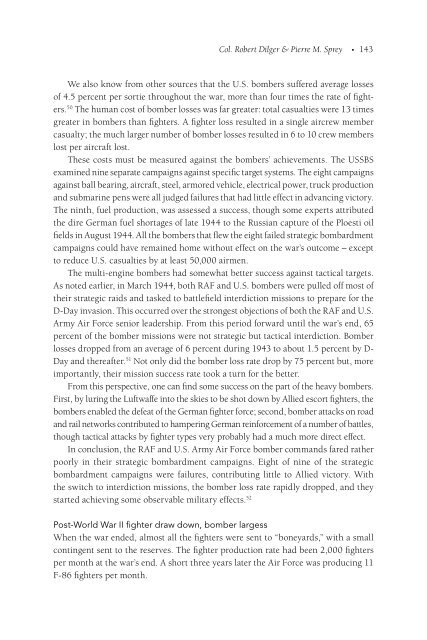Americas Defense Meltdown - IT Acquisition Advisory Council
Americas Defense Meltdown - IT Acquisition Advisory Council
Americas Defense Meltdown - IT Acquisition Advisory Council
You also want an ePaper? Increase the reach of your titles
YUMPU automatically turns print PDFs into web optimized ePapers that Google loves.
Col. Robert Dilger & Pierre M. Sprey • 143We also know from other sources that the U.S. bombers suffered average lossesof 4.5 percent per sortie throughout the war, more than four times the rate of fighters.50 The human cost of bomber losses was far greater: total casualties were 13 timesgreater in bombers than fighters. A fighter loss resulted in a single aircrew membercasualty; the much larger number of bomber losses resulted in 6 to 10 crew memberslost per aircraft lost.These costs must be measured against the bombers’ achievements. The USSBSexamined nine separate campaigns against specific target systems. The eight campaignsagainst ball bearing, aircraft, steel, armored vehicle, electrical power, truck productionand submarine pens were all judged failures that had little effect in advancing victory.The ninth, fuel production, was assessed a success, though some experts attributedthe dire German fuel shortages of late 1944 to the Russian capture of the Ploesti oilfields in August 1944. All the bombers that flew the eight failed strategic bombardmentcampaigns could have remained home without effect on the war’s outcome – exceptto reduce U.S. casualties by at least 50,000 airmen.The multi-engine bombers had somewhat better success against tactical targets.As noted earlier, in March 1944, both RAF and U.S. bombers were pulled off most oftheir strategic raids and tasked to battlefield interdiction missions to prepare for theD-Day invasion. This occurred over the strongest objections of both the RAF and U.S.Army Air Force senior leadership. From this period forward until the war’s end, 65percent of the bomber missions were not strategic but tactical interdiction. Bomberlosses dropped from an average of 6 percent during 1943 to about 1.5 percent by D-Day and thereafter. 51 Not only did the bomber loss rate drop by 75 percent but, moreimportantly, their mission success rate took a turn for the better.From this perspective, one can find some success on the part of the heavy bombers.First, by luring the Luftwaffe into the skies to be shot down by Allied escort fighters, thebombers enabled the defeat of the German fighter force; second, bomber attacks on roadand rail networks contributed to hampering German reinforcement of a number of battles,though tactical attacks by fighter types very probably had a much more direct effect.In conclusion, the RAF and U.S. Army Air Force bomber commands fared ratherpoorly in their strategic bombardment campaigns. Eight of nine of the strategicbombardment campaigns were failures, contributing little to Allied victory. Withthe switch to interdiction missions, the bomber loss rate rapidly dropped, and theystarted achieving some observable military effects. 52Post-World War II fighter draw down, bomber largessWhen the war ended, almost all the fighters were sent to “boneyards,” with a smallcontingent sent to the reserves. The fighter production rate had been 2,000 fightersper month at the war’s end. A short three years later the Air Force was producing 11F-86 fighters per month.


